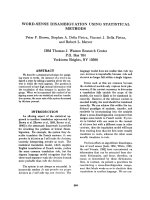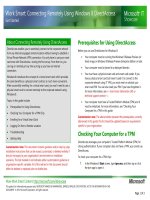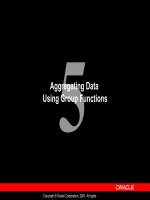Using SQLite pot
Bạn đang xem bản rút gọn của tài liệu. Xem và tải ngay bản đầy đủ của tài liệu tại đây (6.11 MB, 528 trang )
www.it-ebooks.info
www.it-ebooks.info
Using SQLite
www.it-ebooks.info
www.it-ebooks.info
Using SQLite
Jay A. Kreibich
Beijing
•
Cambridge
•
Farnham
•
Köln
•
Sebastopol
•
Taipei
•
Tokyo
www.it-ebooks.info
Using SQLite
by Jay A. Kreibich
Copyright © 2010 Jay A. Kreibich. All rights reserved.
Printed in the United States of America.
Published by O’Reilly Media, Inc., 1005 Gravenstein Highway North, Sebastopol, CA 95472.
O’Reilly
books
may
be purchased for educational, business, or sales promotional use. Online editions
are also available for most titles (). For more information, contact our
corporate/institutional sales department: (800) 998-9938 or
Editor: Mike Loukides
Production Editor: Kristen Borg
Proofreader: Kiel Van Horn
Indexer: Lucie Haskins
Cover Designer: Karen Montgomery
Interior Designer: David Futato
Illustrator: Robert Romano
Printing History:
August 2010:
First Edition.
Nutshell Handbook,
the Nutshell Handbook logo, and the O’Reilly logo are registered trademarks of
O’Reilly Media, Inc. Using SQLite,
the image of a great white heron, and related trade dress are trade-
marks of O’Reilly Media, Inc.
Many of the designations used by manufacturers and sellers to distinguish their products are claimed as
trademarks. Where those designations appear in this book, and O’Reilly Media, Inc., was aware of a
trademark claim, the designations have been printed in caps or initial caps.
While every precaution has been taken in the preparation of this book, the publisher and author assume
no responsibility for errors or omissions, or for damages resulting from the use of the information con-
tained herein.
ISBN: 978-0-596-52118-9
[M]
1281104401
www.it-ebooks.info
To my Great-Uncle Albert “Unken Al” Kreibich.
1918–1994
He took a young boy whose favorite question was
“why?” and taught him to ask the question “how?”
(Who also—much to the dismay of his parents and
the kitchen telephone—taught him the joy of
answering that question, especially if it involved
pliers or screwdrivers.)
—jk
www.it-ebooks.info
www.it-ebooks.info
Table of Contents
Preface . . . . . . . . . . . . . . . . . . . . . . . . . . . . . . . . . . . . . . . . . . . . . . . . . . . . . . . . . . . . . . . . . . . . . xv
1. What Is SQLite?
. . . . . . . . . . . . . . . . . . . . . . . . . . . . . . . . . . . . . . . . . . . . . . . . . . . . . . . . . 1
Self-Contained, No Server Required 2
Single File Database 4
Zero Configuration 4
Embedded Device Support 5
Unique Features 5
Compatible License 6
Highly Reliable 6
2. Uses of SQLite . . . . . . . . . . . . . . . . . . . . . . . . . . . . . . . . . . . . . . . . . . . . . . . . . . . . . . . . . . 9
Database Junior 9
Application Files 10
Application Cache 11
Archives and Data Stores 11
Client/Server Stand-in 11
Teaching Tool 12
Generic SQL Engine 13
Not the Best Choice 13
Big Name Users 15
3. Building and Installing SQLite . . . . . . . . . . . . . . . . . . . . . . . . . . . . . . . . . . . . . . . . . . . . 17
SQLite Products 17
Precompiled Distributions 18
Documentation Distribution 18
Source Distributions 19
The Amalgamation 19
Source Files 19
Source Downloads 20
Building 21
vii
www.it-ebooks.info
Configure 21
Manually 22
Build Customization 23
Build and Installation Options 23
An sqlite3 Primer 24
Summary 26
4. The SQL Language . . . . . . . . . . . . . . . . . . . . . . . . . . . . . . . . . . . . . . . . . . . . . . . . . . . . . 27
Learning SQL 27
Brief Background 28
Declarative 28
Portability 29
General Syntax 30
Basic Syntax 30
Three-Valued Logic 31
Simple Operators 33
SQL Data Languages 34
Data Definition Language 34
Tables 35
Views 43
Indexes 44
Data Manipulation Language 45
Row Modification Commands 46
The Query Command 49
Transaction Control Language 51
ACID Transactions 51
SQL Transactions 53
Save-Points 55
System Catalogs 57
Wrap-up 58
5. The SELECT Command . . . . . . . . . . . . . . . . . . . . . . . . . . . . . . . . . . . . . . . . . . . . . . . . . . 61
SQL Tables 61
The SELECT Pipeline 62
FROM Clause 63
WHERE Clause 68
GROUP BY Clause 69
SELECT Header 70
HAVING Clause 73
DISTINCT Keyword 74
ORDER BY Clause 74
LIMIT and OFFSET Clauses 75
Advanced Techniques 76
viii | Table of Contents
www.it-ebooks.info
Subqueries 76
Compound SELECT Statements 77
Alternate JOIN Notation 78
SELECT Examples 79
Simple SELECTs 80
Simple JOINs 80
JOIN ON 81
JOIN USING, NATURAL JOIN 82
OUTER JOIN 82
Compound JOIN 82
Self JOIN 83
WHERE Examples 83
GROUP BY Examples 84
ORDER BY Examples 85
What’s Next 85
6. Database Design . . .
. . . . . . . . . . . . . . . . . . . . . . . . . . . . . . . . . . . . . . . . . . . . . . . . . . . . 87
Tables and Keys 87
Keys Define the Table 87
Foreign Keys 89
Foreign Key Constraints 90
Generic ID Keys 91
Keep It Specific 92
Common Structures and Relationships 93
One-to-One Relationships 93
One-to-Many Relationships 95
Many-to-Many Relationships 97
Hierarchies and Trees 99
Normal Form 102
Normalization 103
Denormalization 103
The First Normal Form 104
The Second Normal Form 104
The Third Normal Form 105
Higher Normal Forms 106
Indexes 107
How They Work 107
Must Be Diverse 108
INTEGER PRIMARY KEYs 109
Order Matters 109
One at a Time 110
Index Summary 111
Transferring Design Experience 112
Table of Contents | ix
www.it-ebooks.info
Tables Are Types 112
Keys Are Backwards Pointers 113
Do One Thing 113
Closing 114
7. C Programming Interface . . . . . . . . . . . . . . . . . . . . . . . . . . . . . . . . . . . . . . . . . . . . . . 115
API Overview 115
Structure 116
Strings and Unicode 117
Error Codes 118
Structures and Allocations 118
More Info 119
Library Initialization 119
Database Connections 120
Opening 120
Special Cases 121
Closing 122
Example 122
Prepared Statements 123
Statement Life Cycle 123
Prepare 124
Step 126
Result Columns 127
Reset and Finalize 130
Statement Transitions 131
Examples 132
Bound Parameters 133
Parameter Tokens 133
Binding Values 135
Security and Performance 138
Example 140
Potential Pitfalls 141
Convenience Functions 142
Result Codes and Error Codes 146
Standard Codes 146
Extended Codes 148
Error Functions 148
Prepare v2 149
Transactions and Errors 150
Database Locking 151
Utility Functions 156
Version Management 156
Memory Management 157
x | Table of Contents
www.it-ebooks.info
Summary 158
8. Additional Features and APIs . . . . . . . . . . . . . . . . . . . . . . . . . . . . . . . . . . . . . . . . . . . 159
Date and Time Features 159
Application Requirements 160
Representations 160
Time and Date Functions 162
ICU Internationalization Extension 167
Full-Text Search Module 169
Creating and Populating FTS Tables 169
Searching FTS Tables 170
More Details 171
R*Trees and Spatial Indexing Module 171
Scripting Languages and Other Interfaces 172
Perl 172
PHP 173
Python 173
Java 174
Tcl 174
ODBC 175
.NET 175
C++ 175
Other Languages 176
Mobile and Embedded Development 176
Memory 176
Storage 177
Other Resources 178
iPhone Support 178
Other Environments 179
Additional Extensions 180
9. SQL Functions and Extensions . . . . . . . . . . . . . . . . . . . . . . . . . . . . . . . . . . . . . . . . . . . 181
Scalar Functions 182
Registering Functions 182
Extracting Parameters 184
Returning Results and Errors 186
Example 189
Aggregate Functions 194
Defining Aggregates 194
Aggregate Context 195
Example 197
Collation Functions 200
Registering a Collation 201
Table of Contents | xi
www.it-ebooks.info
Collation Example 202
SQLite Extensions 204
Extension Architecture 205
Extension Design 206
Example Extension: sql_trig 207
Building and Integrating Static Extensions 209
Using Loadable Extensions 211
Building Loadable Extensions 212
Loadable Extension Security 213
Loading Loadable Extensions 213
Multiple Entry Points 215
Chapter Summary 215
10. Virtual Tables and Modules . . . . . . . . . . . . . . . . . . . . . . . . . . . . . . . . . . . . . . . . . . . . . 217
Introduction to Modules 218
Internal Modules 218
External Modules 218
Example Modules 219
SQL for Anything 219
Module API 220
Simple Example: dblist Module 224
Create and Connect 224
Disconnect and Destroy 229
Query Optimization 230
Custom Functions 231
Table Rename 232
Opening and Closing Table Cursors 233
Filtering Rows 235
Extracting and Returning Data 237
Virtual Table Modifications 239
Cursor Sequence 240
Transaction Control 241
Register the Module 243
Example Usage 245
Advanced Example: weblog Module 246
Create and Connect 248
Disconnect and Destroy 249
Other Table Functions 250
Open and Close 250
Filter 252
Rows and Columns 254
Register the Module 259
Example Usage 259
xii | Table of Contents
www.it-ebooks.info
Best Index and Filter 262
Purpose and Need 262
xBestIndex() 263
xFilter() 266
Typical Usage 267
Wrap-Up 268
A. SQLite Build Options . . . . . . . . . . . . . . . . . . . . . . . . . . . . . . . . . . . . . . . . . . . . . . . . . . . 269
B. sqlite3 Command Reference . . . . . . . . . . . . . . . . . . . . . . . . . . . . . . . . . . . . . . . . . . . . 287
C. SQLite SQL Command Reference . . . . . . . . . . . . . . . . . . . . . . . . . . . . . . . . . . . . . . . . . 299
D. SQLite SQL Expression Reference . . . . . . . . . . . . . . . . . . . . . . . . . . . . . . . . . . . . . . . . 341
E. SQLite SQL Function Reference . . . . . . . . . . . . . . . . . . . . . . . . . . . . . . . . . . . . . . . . . . 361
F. SQLite SQL PRAGMA Reference . . . . . . . . . . . . . . . . . . . . . . . . . . . . . . . . . . . . . . . . . . 381
G. SQLite C API Reference . . . . . . . . . . . . . . . . . . . . . . . . . . . . . . . . . . . . . . . . . . . . . . . . . 409
Index . . . . . . . . . . . . . . . . . . . . . . . . . . . . . . . . . . . . . . . . . . . . . . . . . . . . . . . . . . . . . . . . . . . . . 491
Table of Contents | xiii
www.it-ebooks.info
www.it-ebooks.info
Preface
This book provides an introduction to the SQLite database product. SQLite is a zero-
configuration, standalone, relational database engine that is designed to be embedded
directly into an application. Database instances are self-contained within a single file,
allowing easy transport and simple setup.
Using SQLite is primarily written for experienced software developers that have never
had a particular need to learn about relational databases. For one reason or another,
you now find yourself with a large data management task, and are hoping a product
like SQLite may provide the answer. To help you out, the various chapters cover the
SQL language, the SQLite C programming API, and the basics of relational database
design, giving you everything you need to successfully integrate SQLite into your ap-
plications and development work.
The book is divided into two major sections. The first part is a traditional set of chapters
that are primarily designed to be read in order. The first two chapters provide an in-
depth look at exactly what SQLite provides and how it can be used. The third chapter
covers downloading and building the library. Chapters Four and Five provide an in-
troduction to the SQL language, while Chapter Six covers database design concepts.
Chapter Seven covers the basics of the C API. Chapter Eight builds on that to cover
more advanced topics, such as storing times and dates, using SQLite from scripting
languages, and utilizing some of the more advanced extensions. Chapters Nine and
Ten cover writing your own custom SQL functions, extensions, and modules.
To complete the picture, the ten chapters are followed by several reference appendixes.
These references cover all of the SQL commands, expressions, and built-in functions
supported by SQLite, as well as documentation for the complete SQLite API.
SQLite Versions
The first edition of this book coves SQLite version 3.6.23.1. As this goes to press, work
on SQLite version 3.7 is being finalized. SQLite 3.7 introduces a new transaction journal
mode known as Write Ahead Logging, or WAL. In some environments, WAL can pro-
vide better concurrent transaction performance than the current rollback journal. This
xv
www.it-ebooks.info
performance comes at a cost, however. WAL has more restrictive operational require-
ments and requires more advanced support from the operating system.
Once WAL has been fully tested and released, look for an article on the O’Reilly website
that covers this new feature and how to get the most out of it.
Email Lists
The SQLite project maintains three mailing lists. If you’re trying to learn more about
SQLite, or have any questions that are not addressed in this book or in the project
documentation, these are often a good place to start.
This list is limited to announcements of new releases, critical bug alerts, and other
significant events in the SQLite community. Traffic is extremely low, and most
messages are posted by the SQLite development team.
This is the main support list for SQLite. It covers a broad range of topics, including
SQL questions, programming questions, and questions about how the library
works. This list is moderately busy.
This list is for people working on the internal code of the SQLite library itself. If
you have questions about how to use the published SQLite API, those questions
belong on the sqlite-users list. Traffic on this list is fairly low.
You can find instructions on how to join these mailing lists on the SQLite website. Visit
for more details.
The email list can be quite helpful, but it is a moderately busy
list. If you’re only a casual user and don’t wish to receive that much email, you can also
access and search list messages through a web archive. Links to several different
archives are available on the SQLite support page.
Example Code Download
The code examples found in this book are available for download from the O’Reilly
website. You can find a link to the examples on the book’s catalog page at http://oreilly
.com/catalog/9780596521196/. The files include both the SQL examples and the C
examples found in later chapters.
xvi | Preface
www.it-ebooks.info
How We Got Here
Taking a book from an idea to a finished product involves a great many people. Al-
though my name is on the cover, this could not have been possible without all of their
help.
First, I would like to acknowledge the friendship and support of my primary editor,
Mike Loukides. Thanks to some mutual friends, I first started doing technical reviews
for Mike over eight years ago. Through the years, Mike gently encouraged me to take
on my own project.
The first step on that path came nearly three years ago. I had downloaded a set of
database exports from the Wikipedia project and was trying to devise a minimal data-
base configuration that would (hopefully) cram nearly all the current data onto a small
flash storage card. The end goal was to provide a local copy of the Wikipedia articles
on an ebook reader I had. SQLite was a natural choice. At some point, frustrated with
trying to understand the correct call sequence, I threw my hands up and exclaimed,
“Someone should write a book about this!”—Ding!—The proverbial light bulb went
off, and many, many (many…) late nights later, here we are.
Behind Mike stands the whole staff of O’Reilly Media. Everyone I interacted with did
their best to help me out, calm me down, and fix my problems—sometimes all at once.
The production staff understands how to make life easy for the author, so that we can
focus on writing and leave the details to someone else.
I would like to thank D. Richard Hipp, the creator and lead maintainer of SQLite. In
addition to coordinating the continued development of SQLite and providing us all
with a high-quality software product, he was also gracious enough to answer numerous
questions, as well as review a final draft of the manuscript. Some tricky spots went
through several revisions, and he was always quick to review things and get back to me
with additional comments.
A technical review was also done by Jon W. Marks. Jon is an old personal and profes-
sional friend with enterprise-class database experience. He has had the opportunity to
mentor several experienced developers as they made their first journey into the rela-
tional database world. Jon provided very insightful feedback, and was able to pinpoint
areas that are often difficult for beginners to grasp.
My final two technical reviewers were Jordan Hawker and Erin Moy. Although they
are knowledgeable developers, they were relatively new to relational databases. As they
went through the learning process, they kept me honest when I started to make too
many assumptions, and kept me on track when I started to skip ahead too quickly.
Preface | xvii
www.it-ebooks.info
I also owe a thank-you to Mike Kulas and all my coworkers at Volition, Inc. In addition
to helping me find the right balance between my professional work and the book work,
Mike helped me navigate our company’s intellectual property policies, making sure
everything was on the straight and narrow. Numerous coworkers also deserve a thank-
you for reviewing small sections, looking at code, asking lots of good questions, and
otherwise putting up with me venting about not having enough time in the day.
A tip of the hat goes out to the crew at the Aroma Café in downtown Champaign,
Illinois. They’re just a few blocks down from my workplace, and a significant portion
of this book was written at their coffee shop. Many thanks to Michael and his staff,
including Kim, Sara, Nichole, and Jerry, for always having a hot and creamy mocha
ready.
Finally, I owe a tremendous debt to my wife, Debbie Fligor, and our two sons. They
were always willing to make time for me to write and showed enormous amounts of
patience and understanding. They all gave more than I had any right to ask, and this
accomplishment is as much theirs as it is mine.
Conventions Used in This Book
The following typographical conventions are used in this book:
Italic
Indicates new terms, URLs, email addresses, filenames, and file extensions.
Constant width
Used for program listings, as well as within paragraphs to refer to program elements
such as variable or function names, databases, data types, environment variables,
statements, and keywords.
Constant width bold
Shows commands or other text that should be typed literally by the user.
Constant width italic
Shows text that should be replaced with user-supplied values or by values deter-
mined by context.
This icon signifies a tip, suggestion, or general note.
This icon indicates a warning or caution.
xviii | Preface
www.it-ebooks.info
Using Code Examples
This book is here to help you get your job done. In general, you may use the code in
this book in your programs and documentation. You do not need to contact us for
permission unless you’re reproducing a significant portion of the code. For example,
writing a program that uses several chunks of code from this book does not require
permission. Selling or distributing a CD-ROM of examples from O’Reilly books does
require permission. Answering a question by citing this book and quoting example
code does not require permission. Incorporating a significant amount of example code
from this book into your product’s documentation does require permission.
We appreciate, but do not require, attribution. An attribution usually includes the title,
author, publisher, and ISBN. For example: “Using SQLite by Jay A. Kreibich. Copyright
2010 O’Reilly Media, Inc., 978-0-596-52118-9.”
If you feel your use of code examples falls outside fair use or the permission given above,
feel free to contact us at
Safari® Books Online
Safari Books Online is an on-demand digital library that lets you easily
search over 7,500
technology and creative reference books and videos to
find the answers you need quickly.
With a subscription, you can read any page and watch any video from our library online.
Read books on your cell phone and mobile devices. Access new titles before they are
available for print, and get exclusive access to manuscripts in development and post
feedback for the authors. Copy and paste code samples, organize your favorites, down-
load chapters, bookmark key sections, create notes, print out pages, and benefit from
tons of other time-saving features.
O’Reilly Media has uploaded this book to the Safari Books Online service. To have full
digital access to this book and others on similar topics from O’Reilly and other pub-
lishers, sign up for free at .
How to Contact Us
Please address comments and questions concerning this book to the publisher:
O’Reilly Media, Inc.
1005 Gravenstein Highway North
Sebastopol, CA 95472
800-998-9938 (in the United States or Canada)
707-829-0515 (international or local)
707 829-0104 (fax)
Preface | xix
www.it-ebooks.info
We have a web page for this book, where we list errata, examples, and any additional
information. You can access this page at:
/>To comment or ask technical questions about this book, send email to:
For more information about our books, conferences, Resource Centers, and the
O’Reilly Network, see our web site at:
xx | Preface
www.it-ebooks.info
CHAPTER 1
What Is SQLite?
In the simplest terms, SQLite is a public-domain software package that provides a
relational database management system, or RDBMS. Relational database systems are
used to store user-defined records in large tables. In addition to data storage and man-
agement, a database engine can process complex query commands that combine data
from multiple tables to generate reports and data summaries. Other popular RDBMS
products include Oracle Database, IBM’s DB2, and Microsoft’s SQL Server on the
commercial side, with MySQL and PostgreSQL being popular open source products.
The “Lite” in SQLite does not refer to its capabilities. Rather, SQLite is lightweight
when it comes to setup complexity, administrative overhead, and resource usage.
SQLite is defined by the following features:
Serverless
SQLite does not require a separate server process or system to operate. The SQLite
library accesses its storage files directly.
Zero Configuration
No server means no setup. Creating an SQLite database instance is as easy as
opening a file.
Cross-Platform
The entire database instance resides in a single cross-platform file, requiring no
administration.
Self-Contained
A single library contains the entire database system, which integrates directly into
a host application.
Small Runtime Footprint
The default build is less than a megabyte of code and requires only a few megabytes
of memory. With some adjustments, both the library size and memory use can be
significantly reduced.
1
www.it-ebooks.info
Transactional
SQLite transactions are fully ACID-compliant, allowing safe access from multiple
processes or threads.
Full-Featured
SQLite supports most of the query language features found in the SQL92 (SQL2)
standard.
Highly Reliable
The SQLite development team takes code testing and verification very seriously.
Overall, SQLite provides a very functional and flexible relational database environment
that consumes minimal resources and creates minimal hassle for developers and users.
Self-Contained, No Server Required
Unlike most RDBMS products, SQLite does not have a client/server architecture. Most
large-scale database systems have a large server package that makes up the database
engine. The database server often consists of multiple processes that work in concert
to manage client connections, file I/O, caches, query optimization, and query process-
ing. A database instance typically consists of a large number of files organized into one
or more directory trees on the server filesystem. In order to access the database, all of
the files must be present and correct. This can make it somewhat difficult to move or
reliably back up a database instance.
All of these components require resources and support from the host computer. Best
practices also dictate that the host system be configured with dedicated service-user
accounts, startup scripts, and dedicated storage, making the database server a very
intrusive piece of software. For this reason, and for performance concerns, it is cus-
tomary to dedicate a host computer system solely for the database server software.
To access the database, client software libraries are typically provided by the database
vendor. These libraries must be integrated into any client application that wishes to
access the database server. These client libraries provide APIs to find and connect to
the database server, as well as set up and execute database queries and commands.
Figure 1-1 shows how everything fits together in a typical client/server RDBMS.
In contrast, SQLite has no separate server. The entire database engine is integrated into
whatever application needs to access a database. The only shared resource among ap-
plications is the single database file as it sits on disk. If you need to move or back up
the database, you can simply copy the file. Figure 1-2 shows the SQLite infrastructure.
By eliminating the server, a significant amount of complexity is removed. This simplifies
the software components and nearly eliminates the need for advanced operating system
support. Unlike a traditional RDBMS server that requires advanced multitasking and
high-performance inter-process communication, SQLite requires little more than the
ability to read and write to some type of storage.
2 | Chapter 1: What Is SQLite?
www.it-ebooks.info
Figure 1-1. Traditional RDBMS client/server architecture that utilizes a client library.
Figure 1-2. The SQLite server-less architecture.
This simplicity makes
it fairly straightforward to port SQLite to just about any envi-
ronment, including mobile phones, handheld media players, game consoles, and other
devices, where no traditional database system could ever dare to venture.
Self-Contained, No Server Required | 3
www.it-ebooks.info









